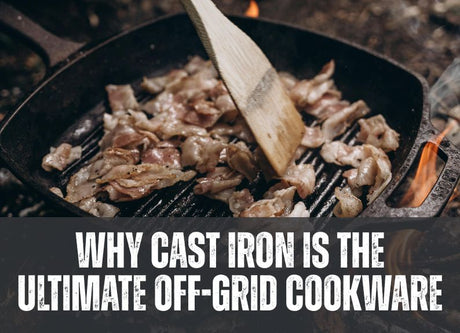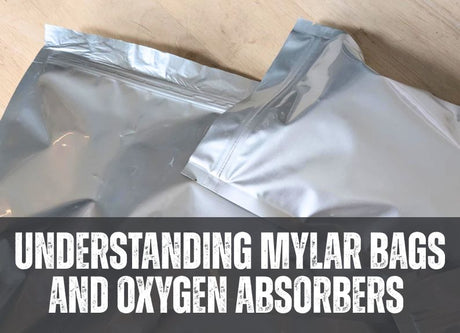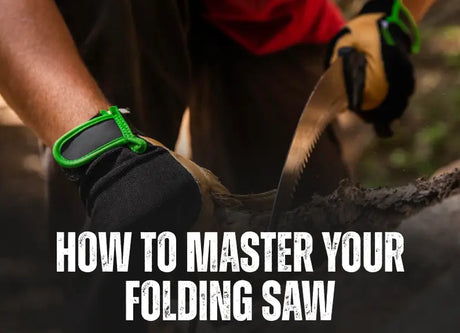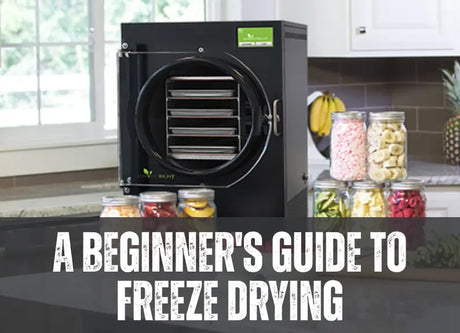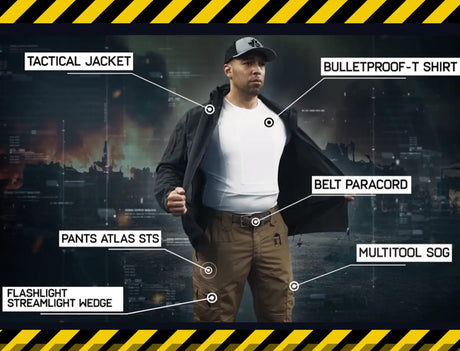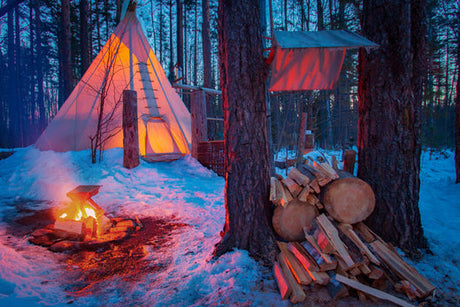Dressing for the cold isn’t as simple as putting on layers. We’re going to break down the three levels of winter cold and how to dress for them. Choosing the right clothing can make all the difference for your survival.
The 3 levels of cold weather
-
Cool: 5 to -10°C / 41 to 14°F
At this level, you have a greater length of time before you’re at risk of freezing, so you can choose gear that will give you more freedom of movement. Be aware, this temperature can often be deceiving. Working up a sweat or waiting longer to get warm can be deadly. Ensure you have a warm space to hunker down in before beginning any other task.
-
Cold: -10 to -20°C / 14 to -4°F
This is a pretty normal winter temperature for a lot of folks in the northern hemisphere. At this level, it is imperative that you remember to wear breathable, wicking layers to prevent wetness. It is also critical that you know the signs and symptoms of hypothermia and how to avoid it. As temperatures decrease even a small amount, you dramatically increase your risk of falling prey to the elements. It is critical that you dress appropriately so that you do not freeze. There is a direct correlation between temperature and the risk of exposure.
-
Extreme: -20 to -50°C / -4 to -58°F
This temperature is more extreme and typically lasts 1-3 weeks in northern central climates. If you live in these areas, it is important to ensure you are prepared to survive in the extreme cold outside of running to your pre-heated car in the winter. If the power goes down or you are trapped outside, being prepared for the elements can be the difference between life and death in a very short amount of time. At this temperature, frostbite can occur in just minutes. Ensuring you know how to survive these conditions is a must whether you are in the city, camping, or bugging out.
How to dress for the 3 levels of winter cold.
Cool - Mild Winter conditions - 90% Synthetic Materials 10% Animal

-
Base:
Polypropylene synthetic or merino wool layers on top and bottom are best. These materials wick away sweat, dry quickly, and are often antimicrobial. Ensure you invest in high-quality base layers for maximum durability and comfort. Never choose a base layer composed of cotton; this material provides zero insulation when wet and takes a long time to dry.
-
Outer:
Lightweight jacket or sweater with windbreaker layer. For legs, we recommend a durable tactical pant. Depending on the amount of work you’ll be doing outside, there are pants to choose from, with added features such as built-in knee pads and additional pockets.
-
Hands:
Light gloves with natural movement or nano dexterity. At these temperatures, you can expect to be doing more complex work on your campsite without risk of frostbite. These gloves can double as a layer underneath Level 3 gloves when you need to work but don’t want to be directly exposed to the elements.
-
Head:
A thin skull cap or beanie will be appropriate in these conditions. Ensure your ears and forehead are covered.
-
Eyes:
Choose sunglasses with polarized lenses and full coverage. In the winter, sun damage can be more dangerous than in the summer months. Protecting your eyes and ensuring you can see your surroundings is an often overlooked survival necessity.
-
Feet:
A lightweight hiking boot or winter boot will give you plenty of mobility as well as warmth. You can also wear a good pair of muck boots if you will be tramping through mixed, wet conditions. We have tried and tested Darn Tough Hunting socks and highly recommend them.
Cold - Moderate to extreme winter conditions - 75% Synthetic 25% Animal

A synthetic or merino wool base layer is essential, and you might want to invest in a thicker or lower temperature rated set to increase insulation.
A good quality winter jacket with down or synthetic fill is a necessity. In dry conditions, choose a high-quality down fill. Do your research and choose a coat that will suit your needs. Remember, a higher down fill rating doesn’t equal more warmth. The fill weight will determine warmth, but these two numbers are equally valuable. For example, a 650 down fill jacket with 330g of down may be as warm as an 800 down fill jacket with only 120g, but the 800 down fill coat will pack lighter and compress more. Consider these numbers carefully, depending on your needs. The Outdoor Survival Canada Massak Jacket features a 650 loft power, of combined premium duck and goose, and is an excellent option for this temperature.
You will also require good quality ski pants. Ensure they come up high on your chest, have a secondary internal layer for wearing comfortably with boots, and feature vents for increased breathability.
Thicker gloves will be necessary, but you can still get reasonable nano dexterity with a thicker glove, ideally made from gore tex – a breathable and durable fabric.
-
Head:
A thicker beanie plus a balaclava or neck scarf. When choosing a neck scarf, ensure it is an enclosed circle or gaiter style and not a long dangling scarf. Long knit scarves can easily catch on things and are also less practical.
-
Eyes:
Sunglasses with polarized lenses might be suitable, but you may also wish to upgrade to a goggle to reduce fogging and increase protection.
-
Feet:
Darn Tough sock with a winter specific boot. A slip resistant sole is recommended for icy conditions and improved movement. Choose a boot rated to about -40°C / F. This will guarantee you will be comfortable to around -20°C / -4°F.
Extreme - dangerous and deadly winter conditions - 40% Synthetic 60% Animal

-
Base:
Synthetic or merino wool. We also recommend a sweater or vest made of wool or fur.
-
Outer:
Invest in a jacket and ski pants that are winter-rated and rugged. Choose a coat with heavy duty zippers and a durable, wind, and waterproof outer shell. You can choose a hood that works best for your needs, but a fur lined hood will provide that extra warmth and comfort. Down fill is recommended for these extreme conditions.
We have tried and tested the Outdoor Survival Canada jackets and highly recommend them for these temperatures. They are durable, feature high quality zippers, and will keep you warm.
-
Hands:
A thinner glove underneath of a full fur mitten. Beaver, coyote, or rabbit fur is all suitable. The fact is, there is no synthetic material that will compete with animal materials in extreme survival conditions. This is especially true if you are pulling a sled over a long distance.
-
Head:
A trapper’s hat will provide adjustable warmth and comfort. Fur is naturally wicking and incredibly warm even when wet, so you can rest assured that you will be protected.
-
Eyes:
Ski goggles will be a necessity to maintain visibility in daylight. Ensure you choose a well-fitting pair with polarized lenses.
- Feet:
Full blown arctic winter boots are a necessity. I highly recommend the Baffin Eiger snow boots, which feature velcro instead of zippers. These will be heavy and difficult to trek in, so ensure you add snowshoes to help lighten your step when navigating snowy terrain.
- Lay down your dry platform
- Stack larger log(s) on one side
- Lay the tinder in the centre and lean the kindling against the larger logs
- Light the tinder and add kindling to the lean as the fire grows, this will dry the larger logs in the process allowing them to ignite as well
The Canadian Prepper essential gear list for dressing in the cold:
- Level 1 Sweater: https://amzn.to/37bpLEd
- Winter Tent Lavvo 6: https://www.canadianpreparedness.com/...
- Fur Mitts (Beaver, Coyote, Raccoon): https://www.canadianpreparedness.com/...
-
Woodstoves: https://www.canadianpreparedness.com/...
- Zapt Pants: https://amzn.to/37cTg8o
- Merino Wool Base Layer: https://amzn.to/2vfdQYE
- Darn Tough Socks: (H variant) https://amzn.to/2UEkQJ5
- Zippo Hand Warmer: https://amzn.to/31B0iD0
- Rabbit Trapper Hat: https://amzn.to/31FhHuf
- North Face Ski Pant: https://amzn.to/2SvPSAj


